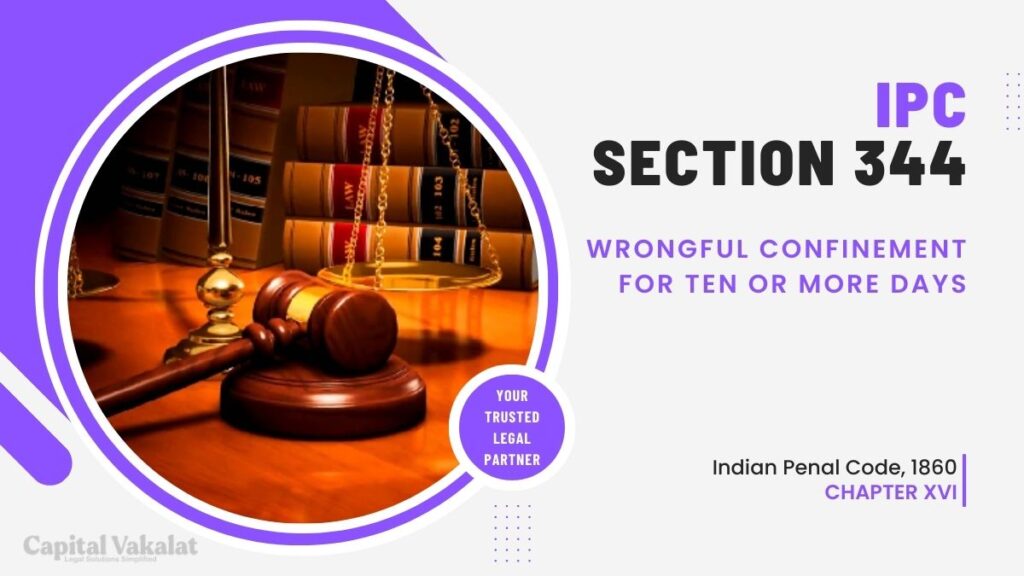In the realm of legal statutes, Section 344 of the Indian Penal Code (IPC) stands as a pivotal provision addressing wrongful confinement, particularly when the duration extends to ten days or more.

This article delves into the intricacies of Section 344, exploring its historical context, legal consequences, notable cases, and the significance of the “ten or more days” clause.
Introduction to Section 344 IPC
The Indian Penal Code, the bedrock of criminal law in India, encapsulates various offenses and their corresponding penalties. Among these, Section 344 holds a distinctive position, outlining the legal ramifications of wrongful confinement. Understanding the implications of this section is crucial for comprehending the nuances of criminal law in the Indian context.
Understanding Wrongful Confinement
Wrongful confinement, as delineated in legal terms, involves the intentional restriction of a person’s freedom without lawful justification. It is imperative to distinguish this offense from related charges such as kidnapping or false imprisonment. Section 344 specifically deals with situations where such confinement extends for a duration of ten days or more, underlining the severity of the act.
Elements of Section 344 IPC
To grasp the essence of Section 344, one must be familiar with the specific elements that constitute wrongful confinement under this provision. This section scrutinizes the conditions that lead to the invocation of Section 344, shedding light on the intricacies of the offense. Furthermore, emphasis is placed on the critical aspect of the confinement lasting for a minimum of ten days.
Legal Consequences of Violating Section 344
Understanding the potential penalties and punishments for violating Section 344 is essential for both legal practitioners and the general public. This section explores the legal consequences perpetrators may face and delves into judicial precedents and case studies that have shaped the application of this law.
Historical Context of Section 344
To appreciate the significance of Section 344, it is essential to explore its historical evolution. This segment of the article provides insights into the origins of the law, tracing its development over time and highlighting key amendments that have molded its present form.
Cases That Shaped the Interpretation of Section 344
A comprehensive understanding of Section 344 requires an examination of landmark cases that have played a pivotal role in shaping the interpretation of this provision. By delving into these cases, readers can gain insights into the nuances of wrongful confinement and its legal implications.
Challenges in Prosecuting Section 344 Cases
Prosecuting cases under Section 344 poses unique challenges, ranging from gathering evidence to proving the elements of confinement. This part of the article explores the hurdles faced by law enforcement and the judiciary in ensuring justice in cases related to wrongful confinement.
Significance of the “Ten or More Days” Clause
The specific duration mentioned in Section 344 raises questions about its significance. This section analyzes the reasoning behind the ten-day threshold, delving into debates and critiques surrounding this particular provision.
Reforms and Amendments Needed
While Section 344 serves as a crucial deterrent against wrongful confinement, there is always room for improvement. This segment proposes reforms and amendments aimed at enhancing the efficacy of Section 344 and aligning it with contemporary legal standards.
Conclusion
In conclusion, Section 344 of the IPC plays a vital role in upholding individual freedoms and safeguarding against wrongful confinement. This article has navigated through its various facets, from its historical context to contemporary challenges, providing a comprehensive understanding of the legal landscape surrounding wrongful confinement for ten or more days.
Frequently Asked Questions
What distinguishes wrongful confinement from kidnapping?
Wrongful confinement involves the intentional restriction of freedom without lawful justification. Kidnapping, on the other hand, typically entails forcibly taking someone away, often with the intent of ransom or other nefarious purposes.
Are there instances where wrongful confinement is justified?
The law recognizes certain justifications for confinement, such as lawful arrest by authorities. However, any intentional and unjustified deprivation of freedom may constitute wrongful confinement.
How has Section 344 evolved over time?
Section 344 has undergone amendments and changes to adapt to evolving legal standards. Understanding its historical context provides insights into the development of this provision.
What reforms are suggested for Section 344?
The article suggests reforms aimed at improving the effectiveness of Section 344, ensuring it remains a robust deterrent against wrongful confinement while addressing contemporary legal challenges.